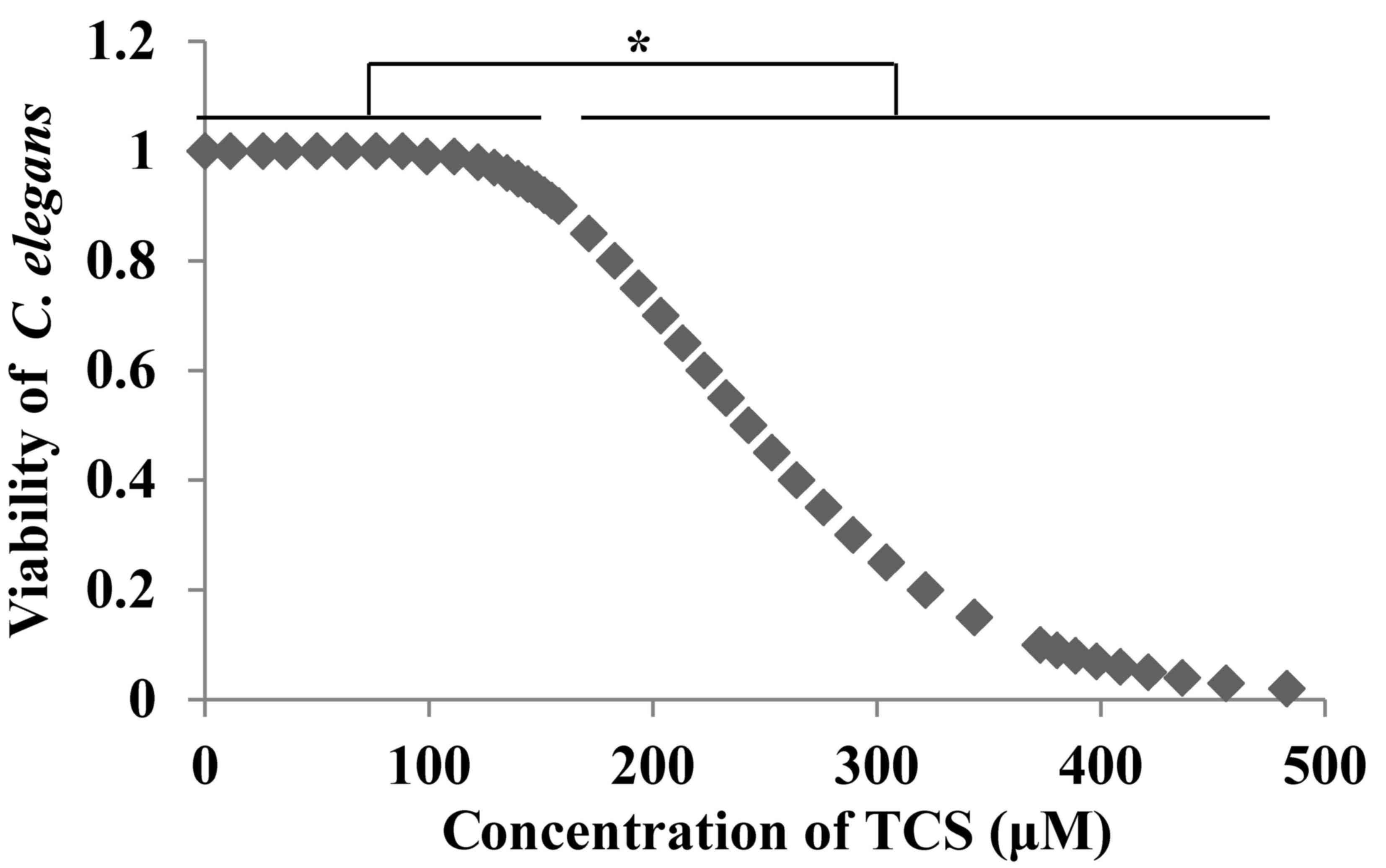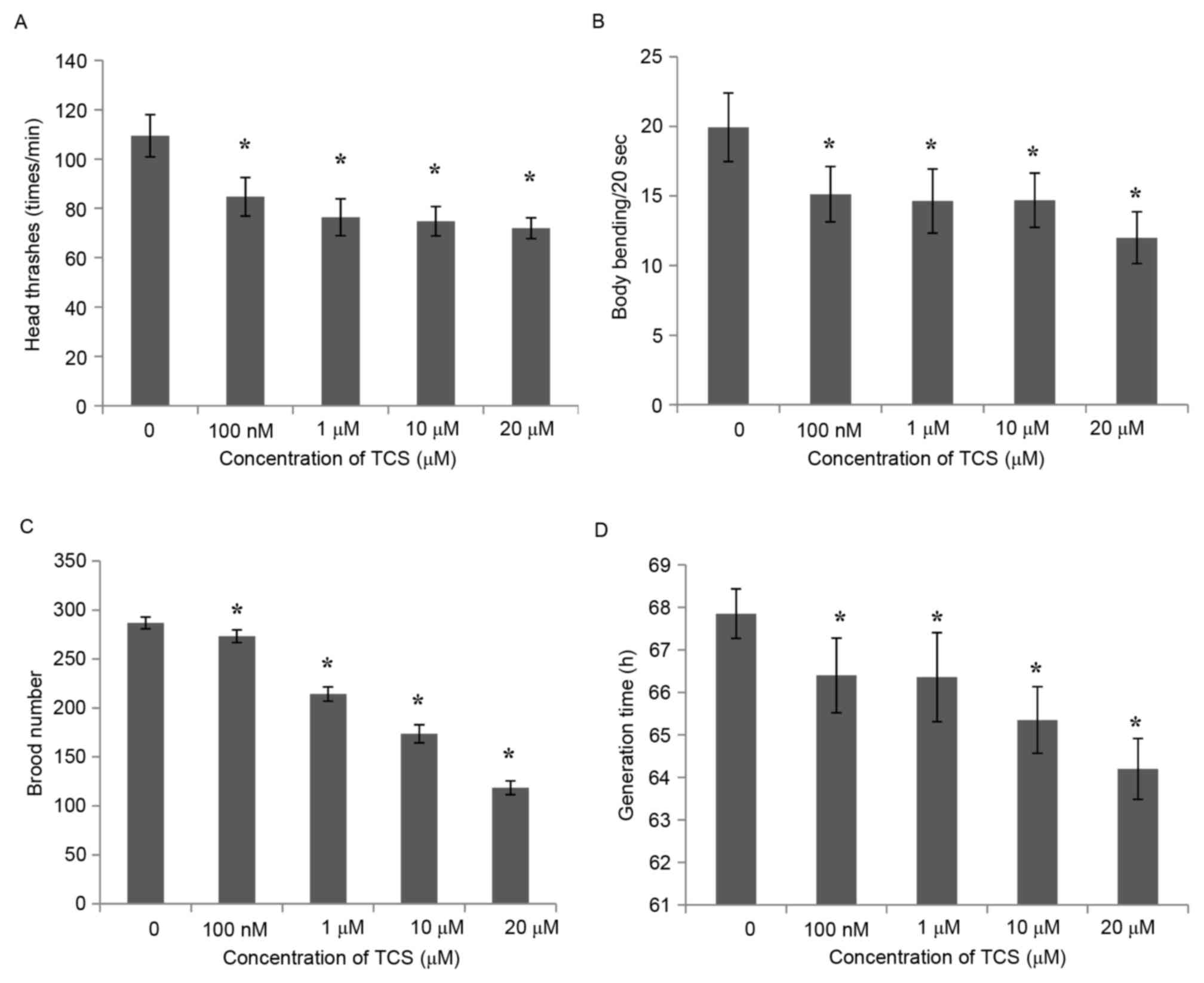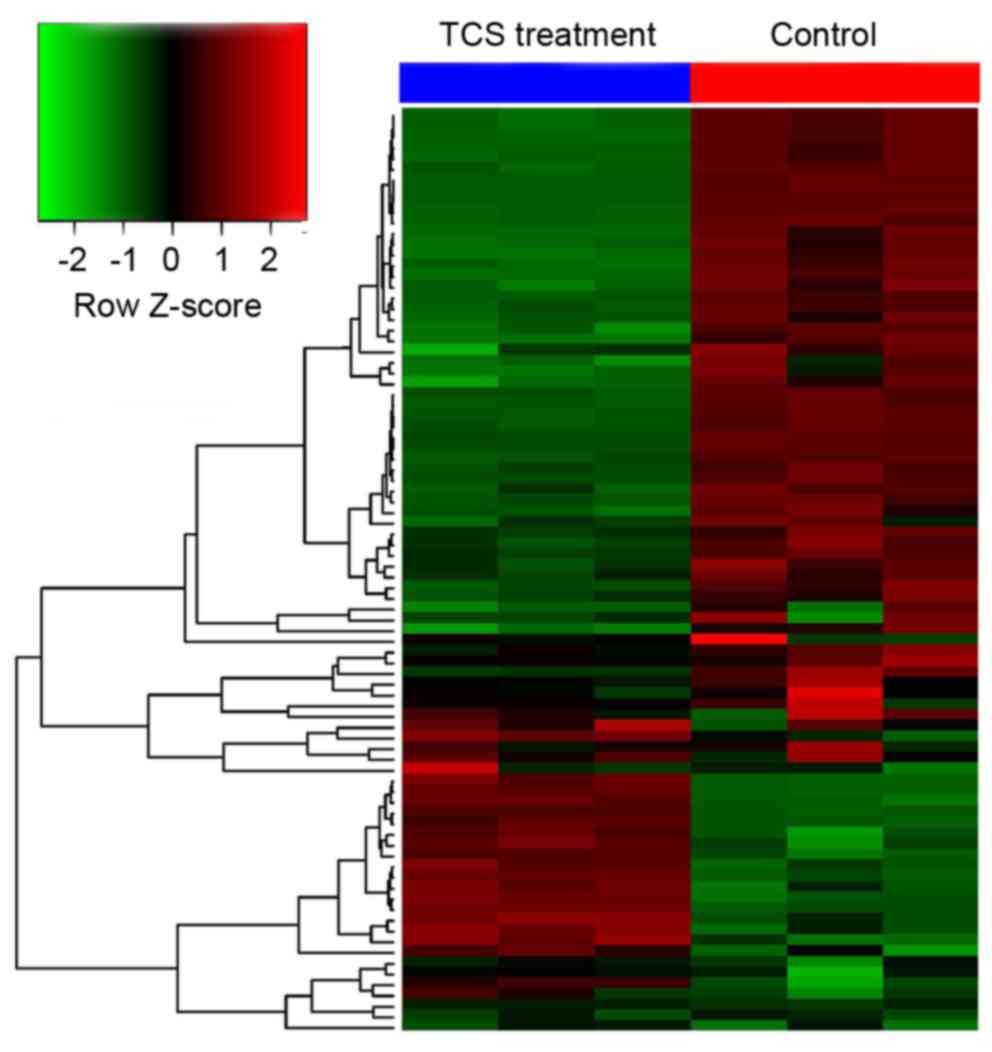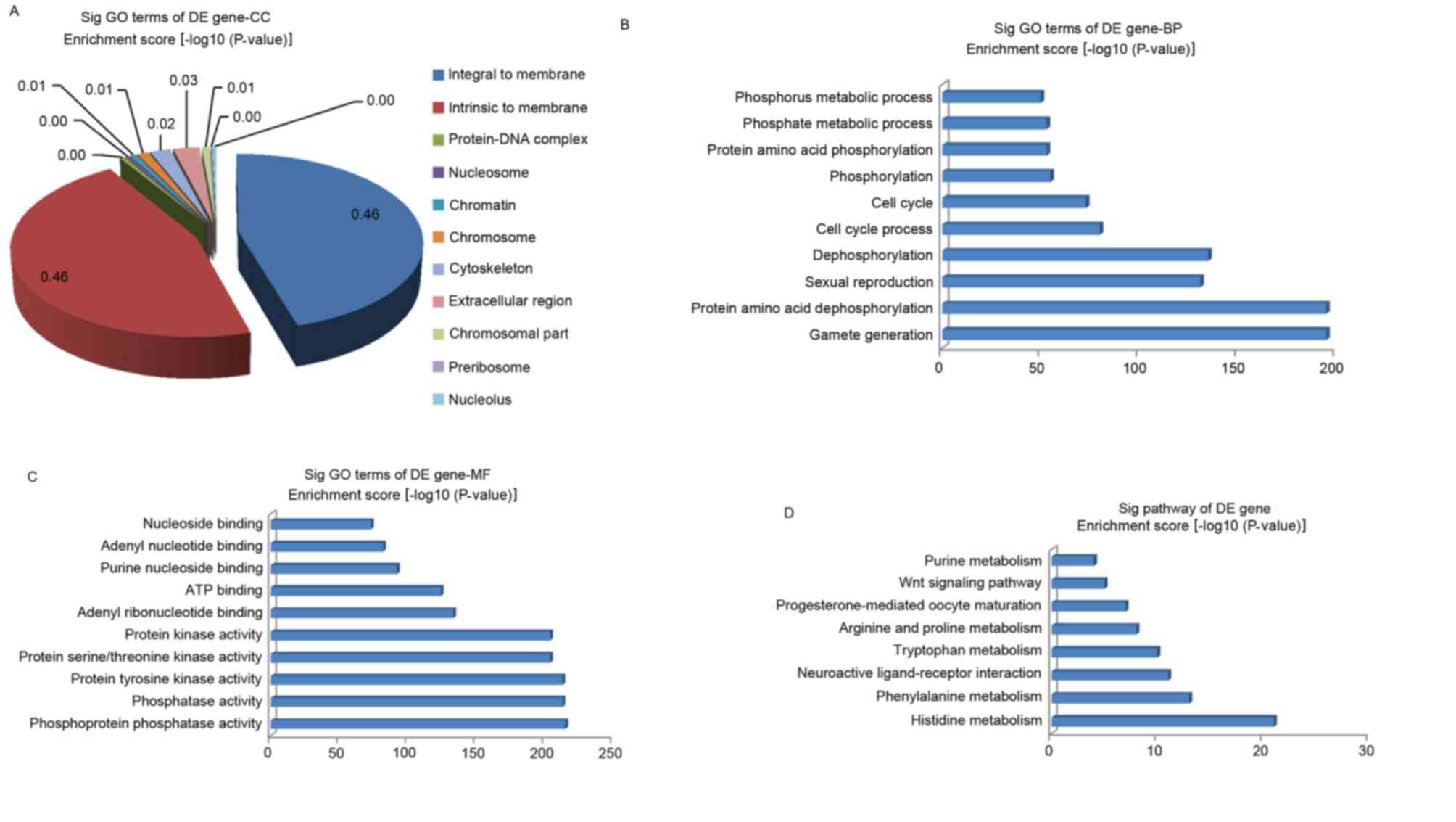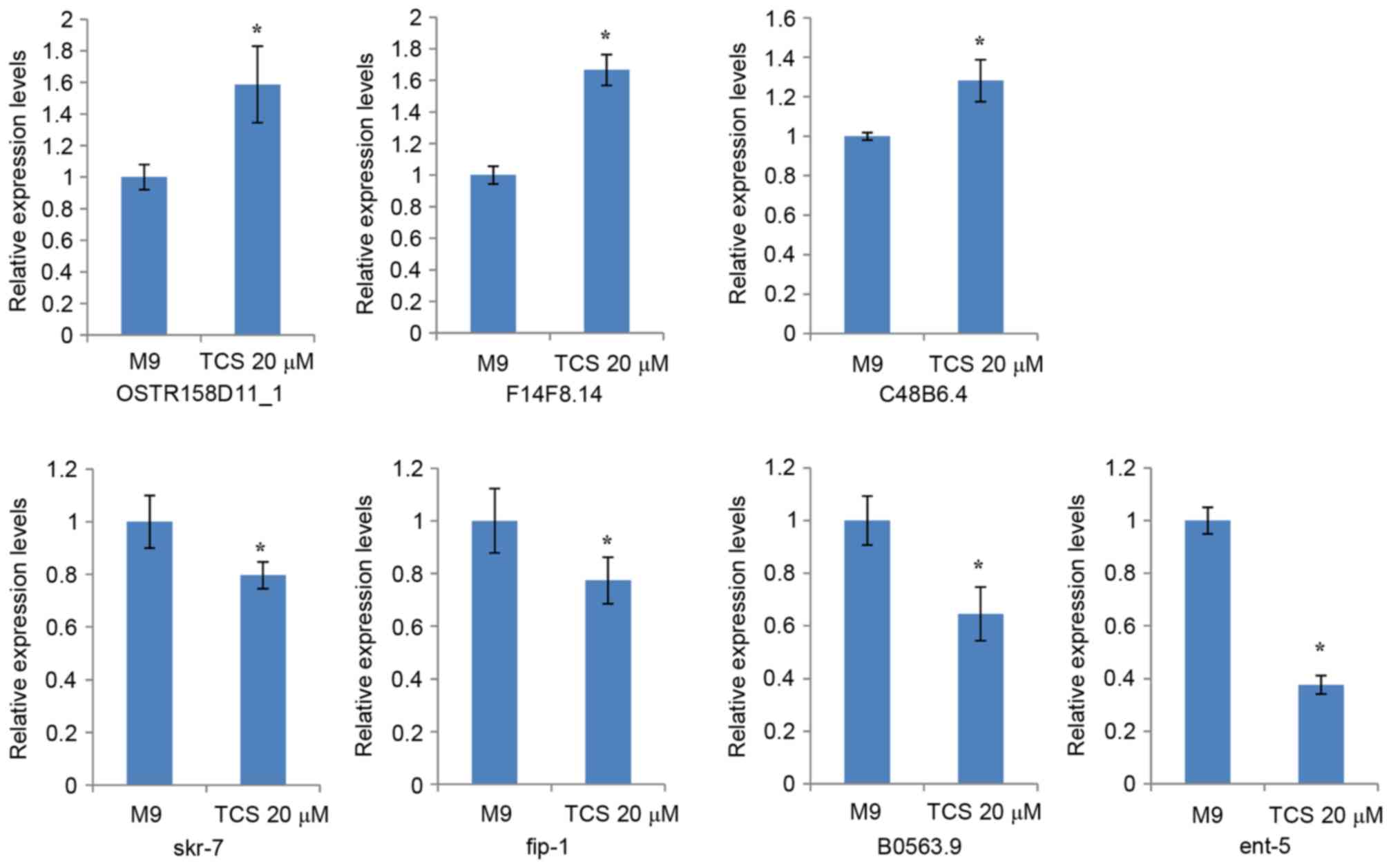|
1
|
Dhillon GS, Kaur S, Pulicharla R, Brar SK,
Cledón M, Verma M and Surampalli RY: Triclosan: Current status,
occurrence, environmental risks and bioaccumulation potential. Int
J Environ Res Public Health. 12:5657–5684. 2015. View Article : Google Scholar : PubMed/NCBI
|
|
2
|
Jung EM, An BS, Choi KC and Jeung EB:
Potential estrogenic activity of triclosan in the uterus of
immature rats and rat pituitary GH3 cells. Toxicol Lett.
208:142–148. 2012. View Article : Google Scholar : PubMed/NCBI
|
|
3
|
Geens T, Dirtu AC, Dirinck E, Malarvannan
G, van Gaal L, Jorens PG and Covaci A: Daily intake of bisphenol A
and triclosan and their association with anthropometric data,
thyroid hormones and weight loss in overweight and obese
individuals. Environ Int. 76:98–105. 2015. View Article : Google Scholar : PubMed/NCBI
|
|
4
|
Xue J, Wu Q, Sakthivel S, Pavithran PV,
Vasukutty JR and Kannan K: Urinary levels of endocrine-disrupting
chemicals, including bisphenols, bisphenol A diglycidyl ethers,
benzophenones, parabens, and triclosan in obese and non-obese
Indian children. Environ Res. 137:120–128. 2015. View Article : Google Scholar : PubMed/NCBI
|
|
5
|
Lee HR, Hwang KA, Nam KH, Kim HC and Choi
KC: Progression of breast cancer cells was enhanced by
endocrine-disrupting chemicals, triclosan and octylphenol, via an
estrogen receptor-dependent signaling pathway in cellular and mouse
xenograft models. Chem Res Toxicol. 27:834–842. 2014. View Article : Google Scholar : PubMed/NCBI
|
|
6
|
Symsaris EC, Fotidis IA, Stasinakis AS and
Angelidaki I: Effects of triclosan, diclofenac, and nonylphenol on
mesophilic and thermophilic methanogenic activity and on the
methanogenic communities. J Hazard Mater. 291:45–51. 2015.
View Article : Google Scholar : PubMed/NCBI
|
|
7
|
Yang YS, Kwon JT, Shim I, Kim HM, Kim P,
Kim JC and Lee K: Evaluation of toxicity to triclosan in rats
following 28 days of exposure to aerosol inhalation. Regul Toxicol
Pharmacol. 71:259–268. 2015. View Article : Google Scholar : PubMed/NCBI
|
|
8
|
Adolfsson-Erici M, Pettersson M, Parkkonen
J and Sturve J: Triclosan, a commonly used bactericide found in
human milk and in the aquatic environment in Sweden. Chemosphere.
46:1485–1489. 2002. View Article : Google Scholar : PubMed/NCBI
|
|
9
|
Dayan AD: Risk assessment of triclosan
[Irgasan] in human breast milk. Food Chem Toxicol. 45:125–129.
2007. View Article : Google Scholar : PubMed/NCBI
|
|
10
|
Hovander L, Malmberg T, Athanasiadou M,
Athanassiadis I, Rahm S, Bergman A and Wehler EK: Identification of
hydroxylated PCB metabolites and other phenolic halogenated
pollutants in human blood plasma. Arch Environ Contam Toxicol.
42:105–117. 2002. View Article : Google Scholar : PubMed/NCBI
|
|
11
|
Allmyr M, McLachlan MS, Sandborgh-Englund
G and Adolfsson-Erici M: Determination of triclosan as its
pentafluorobenzoyl ester in human plasma and milk using electron
capture negative ionization mass spectrometry. Anal Chem.
78:6542–6546. 2006. View Article : Google Scholar : PubMed/NCBI
|
|
12
|
Calafat AM, Ye X, Wong LY, Reidy JA and
Needham LL: Urinary concentrations of triclosan in the U.S.
population: 2003–2004. Environ Health Perspect. 116:303–307. 2008.
View Article : Google Scholar : PubMed/NCBI
|
|
13
|
Li X, Ying GG, Zhao JL, Chen ZF, Lai HJ
and Su HC: 4-Nonylphenol, bisphenol-A and triclosan levels in human
urine of children and students in China, and the effects of
drinking these bottled materials on the levels. Environ Int.
52:81–86. 2013. View Article : Google Scholar : PubMed/NCBI
|
|
14
|
Paul KB, Hedge JM, Devito MJ and Crofton
KM: Developmental triclosan exposure decreases maternal and
neonatal thyroxine in rats. Environ Toxicol Chem. 29:2840–2844.
2010. View
Article : Google Scholar : PubMed/NCBI
|
|
15
|
Axelstad M, Boberg J, Vinggaard AM,
Christiansen S and Hass U: Triclosan exposure reduces thyroxine
levels in pregnant and lactating rat dams and in directly exposed
offspring. Food Chem Toxicol. 59:534–540. 2013. View Article : Google Scholar : PubMed/NCBI
|
|
16
|
Chalasani SH, Chronis N, Tsunozaki M, Gray
JM, Ramot D, Goodman MB and Bargmann CI: Corrigendum: Dissecting a
circuit for olfactory behaviour in Caenorhabditis elegans. Nature.
533:1302016. View Article : Google Scholar : PubMed/NCBI
|
|
17
|
Chatterjee N, Yang JS, Park K, Oh SM, Park
J and Choi J: Screening of toxic potential of graphene family
nanomaterials using in vitro and alternative in vivo toxicity
testing systems. Environ Health Toxicol. 30:e20150072015.
View Article : Google Scholar : PubMed/NCBI
|
|
18
|
Tedesco P, Visone M, Parrilli E, Tutino
ML, Perrin E, Maida I, Fani R, Ballestriero F, Santos R, Pinilla C,
et al: Investigating the role of the host multidrug resistance
associated protein transporter family in burkholderia cepacia
complex pathogenicity using a Caenorhabditis elegans infection
model. PLoS One. 10:e01428832015. View Article : Google Scholar : PubMed/NCBI
|
|
19
|
Zhao Y, Yu X, Jia R, Yang R, Rui Q and
Wang D: Lactic acid bacteria protects Caenorhabditis elegans from
toxicity of graphene oxide by maintaining normal intestinal
permeability under different genetic backgrounds. Sci Rep.
5:172332015. View Article : Google Scholar : PubMed/NCBI
|
|
20
|
Srivastava S, Pant A, Trivedi S and Pandey
R: Curcumin and β-caryophellene attenuate cadmium quantum dots
induced oxidative stress and lethality in Caenorhabditis elegans
model system. Environ Toxicol Pharmacol. 42:55–62. 2016. View Article : Google Scholar : PubMed/NCBI
|
|
21
|
Warnhoff K and Kornfeld K: New links
between protein N-terminal acetylation, dauer diapause and the
insulin/IGF-1 signaling pathway in Caenorhabditis elegans. Worm.
4:e10234982015. View Article : Google Scholar : PubMed/NCBI
|
|
22
|
Roussel N, Sprenger J, Tappan SJ and
Glaser JR: Robust tracking and quantification of C. elegans body
shape and locomotion through coiling, entanglement, and omega
bends. Worm. 3:e9824372015. View Article : Google Scholar : PubMed/NCBI
|
|
23
|
Lv J, Xia K, Xu P, Sun E, Ma J, Gao S,
Zhou Q, Zhang M, Wang F, Chen F, et al: miRNA expression patterns
in chemoresistant breast cancer tissues. Biomed Pharmacother.
68:935–942. 2014. View Article : Google Scholar : PubMed/NCBI
|
|
24
|
Lv J, Fu Z, Shi M, Xia K, Ji C, Xu P, Lv
M, Pan B, Dai L and Xie H: Systematic analysis of gene expression
pattern in has-miR-760 overexpressed resistance of the MCF-7 human
breast cancer cell to doxorubicin. Biomed Pharmacother. 69:162–169.
2015. View Article : Google Scholar : PubMed/NCBI
|
|
25
|
Zhang W, Wang F, Xu P, Miao C, Zeng X, Cui
X, Lu C, Xie H, Yin H, Chen F, et al: Perfluorooctanoic acid
stimulates breast cancer cells invasion and up-regulates matrix
metalloproteinase-2/−9 expression mediated by activating NF-κB.
Toxicol Lett. 229:118–125. 2014. View Article : Google Scholar : PubMed/NCBI
|
|
26
|
Livak KJ and Schmittgen TD: Analysis of
relative gene expression data using real-time quantitative PCR and
the 2(−Delta Delta C(T)) method. Methods. 25:402–408. 2001.
View Article : Google Scholar : PubMed/NCBI
|
|
27
|
Jung EM, An BS, Choi KC and Jeung EB:
Potential estrogenic activity of triclosan in the uterus of
immature rats and rat pituitary GH3 cells. Toxicol Lett.
208:142–148. 2011. View Article : Google Scholar : PubMed/NCBI
|
|
28
|
Xiao J, Vemula SR, Xue Y, Khan MM,
Kuruvilla KP, Marquez-Lona EM, Cobb MR and LeDoux MS: Motor
phenotypes and molecular networks associated with germline
deficiency of Ciz1. Exp Neurol. 283:110–120. 2016. View Article : Google Scholar : PubMed/NCBI
|
|
29
|
Tribulo P, Moss JI, Ozawa M, Jiang Z, Tian
XC and Hansen PJ: WNT regulation of embryonic development likely
involves pathways independent of nuclear CTNNB1. Reproduction.
153:405–419. 2017. View Article : Google Scholar : PubMed/NCBI
|
|
30
|
Nayak S, Santiago FE, Jin H, Lin D, Schedl
T and Kipreos ET: The Caenorhabditis elegans Skp1-related gene
family: Diverse functions in cell proliferation, morphogenesis, and
meiosis. Curr Biol. 12:277–287. 2002. View Article : Google Scholar : PubMed/NCBI
|















